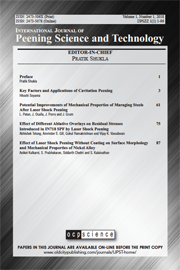 IJPST Home · Issue Contents · Editorial Board
IJPST Home · Issue Contents · Editorial Board
Subscription Info · Contributor Notes · Online Submissions · Call for Papers · Recommend
International Journal of Peening Science & Technology
Editor-in-Chief: Pratik Shukla
ISSN: 2473-506X (print)
ISSN: 2473-5078 (online)
64 pages/issue · 6″ x 9″
Issue Coverage: Volume 1 – present
Aims and Scope
The International Journal of Peening Science and Technology (IJPST) aims to provide a global and transdisciplinary forum for the exchange of the science, technology, developments and applications surrounding the wide variety of peening and surface treatment techniques available. The Journal highlights the latest development which these technologies have made to provide both, academic and industrial progress. Emphasis is placed on both the theoretical and practical contributions in relation to the science behind the methods, technologies, new applications/materials, and evaluates results and developments of enhanced solutions, new experimental methods and associated phenomena. Original research papers, case studies, review papers, short communications, mini reviews and letters to editor are all welcome.
The scope of the journal is defined to include, but not limited to, the following areas: laser shock peening (LSP); plasma physics and dynamics; plasma-driven shock-wave based processes; shot peening; blast and laser cleaning; grit blasting; ultrasonic peening; water-jet/cavitation peening; oil-jet peening; ion exchange beam peening; low plasticity burnishing and deep rolling; other material strengthening treatments; issues on plastic deformation and strengthening mechanisms; residual stresses and its management in materials; finite element analysis (FEA) and process modelling of the aforementioned techniques and processes; implementation of machine learning/artificial intelligence to surface/bulk materials processing technologies; additive manufacturing; hybrid processing; digitization and process optimization; novel surface processing systems; development of new machinery/accessories/equipment for surface enhancement of materials and components; Peening Process monitoring and digitalisation including artificial intelligence; Post and hybrid Processing of Additive Manufacturing Technology. The journal also includes the evaluation of topographical and micro and nano structural characteristics; change in mechanical, electrical and biomedical properties using such peening techniques and surface enhancement methods, and reflects the main areas in which these methods are used and developed for surface engineering and manufacturing applications.
